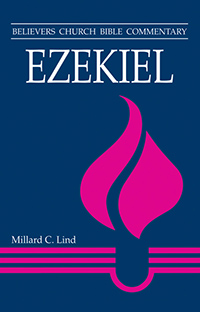Ezekiel's Political Theology (in Ezekiel)
![]() Home A B C D E F G H I J K L M N O P Q R S T U V W X Y Z Abbreviations Glossary
Home A B C D E F G H I J K L M N O P Q R S T U V W X Y Z Abbreviations Glossary
This essay is made up of six reflections on the theology of the book of Ezekiel from the perspective of his final vision.
1. The book of Ezekiel tells about the victory of the rule of God. Ezekiel’s temple vision is the climax of a movement throughout the book, a movement which compares to the story of Israel’s ancient worship. The book begins with a theophany, the appearance of God in a war chariot to commission the prophet Ezekiel as the Lord’s sentinel (chaps. 1–3). In this role, Ezekiel warns rebellious Jerusalem and the nations of their impending doom (chaps. 4–32). After the fall of Jerusalem, the “continental divide” of his ministry, Ezekiel proclaims the Lord’s victory. God will establish a resurrected community in a renewed land (chaps. 33; 34–37), and God will provide for that community new structures of power and authority for governance in that land (chaps. 40–48).
2. The temple vision of Ezekiel is set within the context of God’s concern for the nations and against the background of the Lord’s defeat of Gog (37:26–28; chaps. 38–39). God’s purpose in establishing the sanctuary in Israel is that the nations might acknowledge that Israel is set apart as their spiritual and moral exemplar (37:28; cf. 5:5). God’s purpose in defeating Gog, a story sandwiched between the prediction of temple building and Ezekiel’s vision, is that the nations might acknowledge the rule of the Lord, a rule which requires a moral rather than military interpretation of history (39:23; cf. 37:26–28; 40:1–2). Gog symbolizes the pretension of empire to rule history by human wisdom and violence. Against that pretension, Ezekiel presents a vision of the Lord’s rule of a community through new structures of power and authority given by God.
3. Access to the Lord, who rules from the temple, is by way of the altar. Its worship emphasizes cleansing, forgiveness, and reconciliation (43:13–46:24). From this temple a living stream flows out to cleanse and water and heal the land (47:1–12).
4. Ezekiel’s vision marks a division between the secular and the Holy. The territory of the city is not included within the holy oblation, nor is the temple any longer within the territory of the city (48:10, 15, 18, KJV). Through the prophet, “constitutional law” is proclaimed by the Lord of the temple, and this law both prince and people are to obey. The city is named The Lord Is There, not because the temple is now regarded as within the city, but because the city acknowledges its secularity; it does not intrude upon the authority of the Holy but subjects itself to the Holy.
5. The city is integrated into the covenant structure of the tribes, with egalitarian concepts of justice. No longer is it the “city of David,” owned by the prince. The prince is not to intrude upon the rule of God. Likewise, he is not to intrude upon the rights of the people.
6. Ezekiel’s clear boundary between holy and secular has implications not only for politics but also for worship. [Worship, p. 382.] The Lord is a personal God who is not to be identified with the impersonal powers of economics or human politics. Ezekiel’s boundaries anticipate the prayer of Jesus to the Father who is in heaven, whose name is to be hallowed, whose will is to be done on earth, and who gives bread and forgiveness to all who ask (Matt. 6:9–13).
| —Millard Lind |
